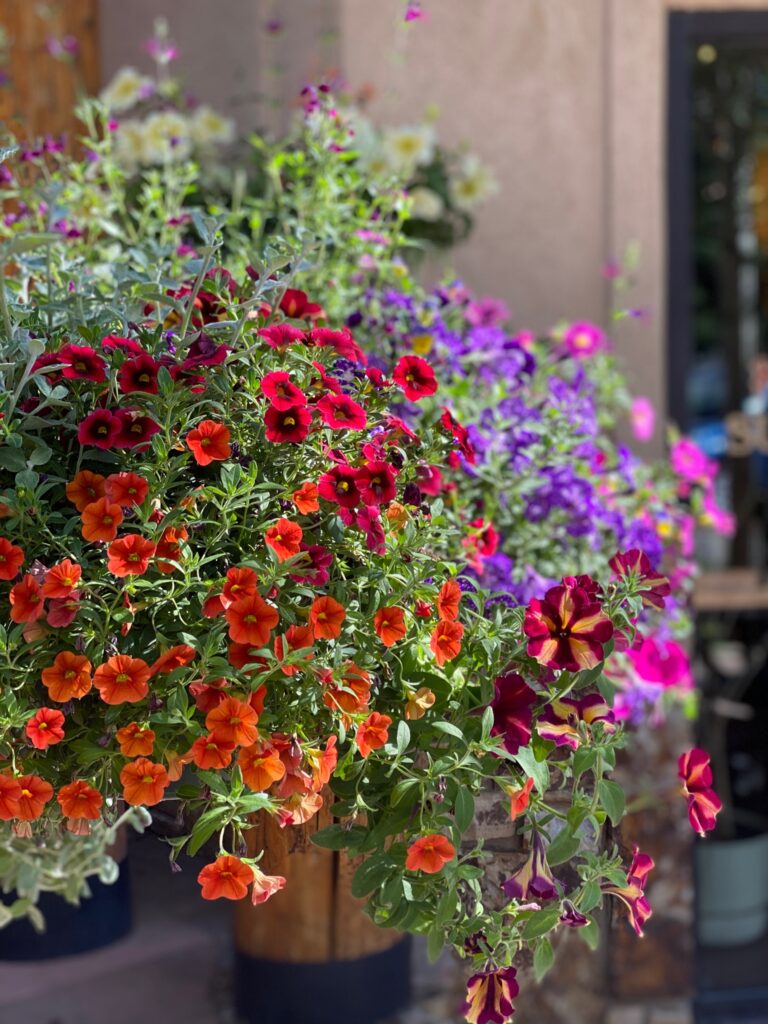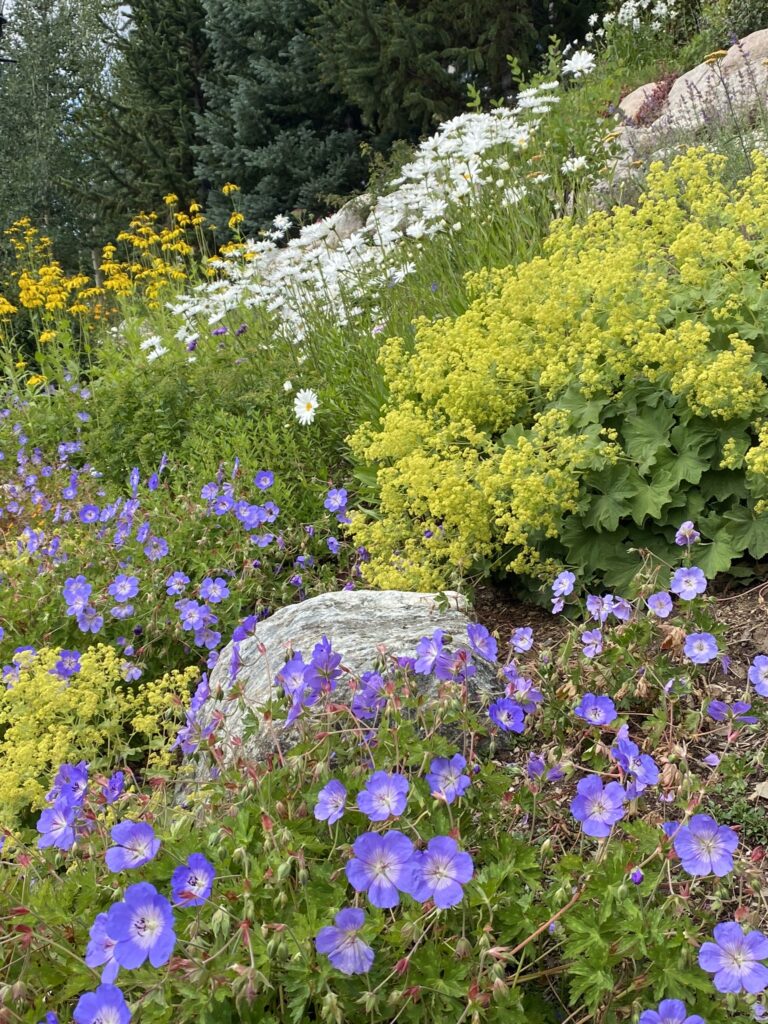Typically, when we are discussing landscape and garden design we hear terms like line, form, texture, color, scale, proportion, order, repetition, unity and rhythm. While these principles are important, how can we simplify them and think like a designer in our own mountain gardens? Here are a few tips to think about when planning and creating your own personal plant oasis.
- Envision how you want to use your space- This will look different for everyone! Maybe you are the neighborhood entertainer, and you envision a fun, welcoming atmosphere to gather, grill, and connect with your friends and neighbors. Perhaps you want the space to be a quiet, relaxing place to unwind after work with a few plants and a spot to read and do yoga. A food garden to teach and learn with your kids may be a great place to introduce them to gardening and cooking together.
- Remember the basics – Picture this, you have been dreaming about a big field of poppies and grand burst of oranges and reds in a certain area of your garden, but this specific area only receives about 2 hours of direct sunlight, and the poppies are asking for closer to 6 hours. You will need to pick a new plant for this shady area, and hopefully find a new home with more sun for the poppies. Think about sun exposure. Next you need to be aware of your gardening zone for plant shopping, and your average last frost dates to determine your safe planting dates and length of your season. Did I lose you? Check out more information in our Blog For the Newbie Gardener. These numbers and dates are vital when picking out your perennials, trees, shrubs, and seeds.
- Think long term and give your plants space to grow- Often when I am laying out new plants for planting, I am thinking about 3-5 years in the future. Gardening requires quite a bit of patience, especially in the Colorado mountains with our short growing season and unique challenges. Your plant tags will tell you the mature size and spread of the plant, it can be deceiving when seeing a young perennial at the nursery much smaller to begin with. Crowding plants in and not giving them enough space will create more work for you in the long term when they begin to compete for room to grow and resources.
- Remember to include Spring, Summer, and Fall bloomers in your garden- Perennials (flowers that overwinter and return next season) have a specific “time to shine” and typically bloom for 4-6 weeks depending on the plant. Some can rebloom or continue for longer with proper deadheading. Keeping this in mind, I wouldn’t recommend only planting Spring bloomers. For example, you visit the nursery in Spring and pick only plants that are currently blooming. You get them in the ground and unfortunately by July your garden is “post-peak” and no longer colorful.
Using a combination of Spring, Summer, and Fall bloomers will ensure you have something blooming throughout the entire season and give one garden several different looks each year. As the early bloomers tire, certain plants will begin to die back, giving you a natural cue to cut back and give the space to the next plants ready to “peak.”
If you are a visitor or second homeowner, think about what time of the season you spend in your mountain home and pick plants that thrive during your visit. If you don’t arrive until July, you may want to skip the Spring blooming bulbs and perennials.
- Think about layout, groupings, and colors- When thinking about layout think simply, taller in back, mounding and medium in the middle, and short in front. There is no reason for a blooming groundcover to be hiding in the back, and a plant too tall in the front may take too much space blocking others behind it.
Groupings and masses can also be important. I would consider myself more of a specimen type gardener in my own space, I like to try and experiment with unique plants and see what works. However, in a larger space groupings and mass plantings offer a grand visual experience. I also like to space out in a “stagger” instead of a straight line to provide a more natural feel.
Typically, we suggest groupings in odd numbers (3, 5, 7) and sticking to 1-3 colors per area of the garden. While this may work in certain situations, at the end of the day it is your garden and if you like a rainbow of colors and odd number groupings go for it.
- Use a mix of perennials, trees, shrubs, bulbs, and annuals- Different types of plants provide their own unique interest to the mountain garden and landscape. Trees and shrubs are available in various sizes, shapes, and forms. Their leaves and blooms offer additional Spring, Summer, and Fall interest. Evergreens offer something extra in the winter months. They also provide great habitats for local pollinators, birds and wildlife.
Bulbs, perennial, and annuals also have an important place in the garden. I would not stick to just one of these options and use a mix of them all. Bulbs are affordable, easy to plant, and I am especially a fan of Spring blooming bulbs like tulips and daffodils that offer some of the first colors and blooms when the snow melts. Perennials return for several seasons (life span depends on the plant, some survive 3 years, some forever), but only bloom for 4-6 weeks and require 3-5 seasons to mature.
Annuals bloom all season long, but do not overwinter and require more water, fertilizers, and resources. Some may drop their seeds and create a new plant for next season, but we typically look at annuals as an instant color enhancer for one season. Annuals are a great option to try something fun and fill in some spaces while waiting for perennials to mature and fill in.
- Look for inspiration, observe your surroundings, and add your own personal touches- My favorite Colorado mountain gardens are those that mimic their natural surroundings and appear to just be a part of the existing landscape. Think about using natural borders and lines instead of staying straight, and work with complimenting materials like rocks and stones. Visit local botanic and observation gardens, participate in your town’s garden tour, and sign up for a class at a local garden center or nursery.
At the end of the day this garden and space is yours to enjoy and use as you best see fit. If you look closely in my own garden, you will start to see garden guests like gnomes and birds sharing the space with me. This may not be everyone’s style, but these little guests remind me of various gardens and expeditions around the country and a collection that began with a gift from my own grandmother’s garden in Boulder. I love having a piece of her with me in my own garden. I also enjoy having a designated kitchen garden with easy access and a sitting area for coffee, reading, and writing with morning sun.
My last advice when planning and designing your mountain garden is to remember that gardening is a constant series of trials and errors. What works for one person may not work in your own garden. Be prepared to move things around, add and remove plants as needed, and adjust things like watering and feeding each season with environmental changes. A successful Colorado mountain garden requires patience, experimentation, and an ability to adapt and change as needed.





















